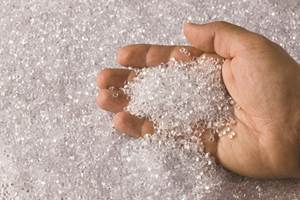North America's Best-Kept Secret in Compounding
They’re hardly a startup, having opened their doors 27 years ago this month.
They’re hardly a startup, having opened their doors 27 years ago this month. But since 1983, custom compounder Modern Concepts has maintained a fairly low profile from its 40,000-ft² facility in Compton, Calif. However, because of the company’s commitment to investing in technology and its willingness to finance acquisitions while many others are retrenching, the secret is out.
Modern Concepts was founded by Richard Warpack, who had spent the previous 14 years of his career with color concentrate producer Plastics Molding Supply (PMS), now part of PolyOne Corp. For most of the company’s history, Warpack and Aris Barrios, v.p. of operations, grew the company organically. Over the past two years, the bulk of its business has been in PP formulations, but Modern basically “processes everything under the sun except PVC,” remarks Barrios. That includes all types of PE as well as PET, ABS, PC, acrylic, and more.
The company found its niche in small orders, the kind of business “the big boys typically don’t want to look at,” notes Warpack. It’s an advantage the compounder still holds, though Modern Concepts is fully capable of producing truckload quantities as well.
Modern currently employs 55 people. Its primary business is color, but the firm is also heavily involved in custom-tailored compounds and glass-filled formulations. It is also active in private labeling and has developed its own line of TPOs. Modern serves most processing markets except for film; processors there tend to gravitate toward much higher-volume suppliers because of the quantities of resin they consume.
Barrios’ previous experience was in injection molding and moldmaking—he was actually a client of Warpack’s until he joined forces with him 17 years ago. It’s a background that comes in handy when Modern sits down with clients. “We found when meeting with customers, whether they were processors or end users, many didn’t know they were using resins that were over-engineered for the application. We developed quite a few custom formulations over the years, mostly based on glass-filled PP, that meet the performance the customer needed at a lower cost.
“A lot more interaction with customers is required today because so many of them have lost key technical people,” continues Barrios. “Our advantage is that we have processing and materials-selection knowledge under our belts, as well as flexibility. Projects today require a lot of communication between us, processors, and end users, and we’re in the position to offer a variety of customized solutions.”
GROWTH THROUGH ACQUISITIONS
The opportunity to expand by taking out competitors presented itself as the economy slowed to a crawl and business conditions began to deteriorate over the last couple of years. In July 2008, Modern took over Marco Color Labs of Hawthorne, Calif. About a year later, it acquired MKS Color Composites in Costa Mesa, Calif.
“Our business at the time was on solid footing, even though the economy was weak,” recalls Warpack. “We had established ourselves, first locally, than nationally, then internationally. We did not seek out these acquisitions, but when they were presented to us we were able to take advantage.”
The acquisitions gave Modern access to new customers and formulations. “We were able to gain access to new clients without having to call on them from scratch,” says Barrios. “They already had the formulations, it was just a matter for us to produce them.” Warpack indicates that another acquisition is possible down the line, as he has been approached by a competitor interested in a buyout.
The additional business has put Modern in a bit of a quandary. It is currently “stuffed in” its California plant, and plans are on the horizon to expand by another 20,000 ft². Warpack says his preference is to build onto his current location, though he would not rule out a move to a new facility.
Modern’s business is based heavily on the ability to turn over orders quickly. As a result, it carries quite a bit of inventory—in excess of $1 million—and will add to that supply if the price is right, whether or not it has immediate need for that particular resin. Says Barrios, “We’re not just working for today. We have to be primed for growth in the future. Our customers don’t want to hear about two-week lead times.”
Adds Warpack, “I am not a particular fan of just-in-time delivery in our business because it places too much reliance on the supplier. We’re heavily stocked. We’ve weathered the storm of price fluctuations. Right now we’re sitting on a railcar of LLDPE and truckloads of PET and PP, among other things.”
Modern Concepts relies primarily on twin-screw compounders, running nine corotating, intermeshing machines from 34 to 82 mm diam. built by Leistritz, Somerville, N.J. (leistritz-extrusion.com). Recently, Modern augmented its capacity with two single-screw machines bought at an auction, which it expects to use primarily for its TPO product line, owing to that material’s shear sensitivity. Modern operates both strand and water-ring pelletizers.
Warpack says Modern is looking at adding a 90-mm twin-screw, as well as more smaller machines. “We’re currently facing somewhat of a bottleneck on smaller orders, so we believe we need additional small-machine capacity,” he says. “Orders for masterbatch in the 50- to 100-lb range are currently straining our smaller lines.”
While the plastics industry as a whole is expecting very little growth this year, Modern Concepts has met its significantly more ambitious goals. For fiscal-year 2009 (Modern’s financial calendar runs from April to April), sales will exceed $10 million, which represents a 25% leap from FY ’08.
Warpack said plans are on the drawing board for a significant expansion in two or three years. “We’re healthy financially, we have a loyal customer base, and a considerable amount of momentum going,” says Barrios. “Our low-key approach has taken a lot of people by surprise. But I guess, with customers all over the world now, we’re having a coming-out party.”
Related Content
The Fundamentals of Polyethylene – Part 1: The Basics
You would think we’d know all there is to know about a material that was commercialized 80 years ago. Not so for polyethylene. Let’s start by brushing up on the basics.
Read MoreFundamentals of Polyethylene – Part 6: PE Performance
Don’t assume you know everything there is to know about PE because it’s been around so long. Here is yet another example of how the performance of PE is influenced by molecular weight and density.
Read MorePolyethylene Fundamentals – Part 4: Failed HDPE Case Study
Injection molders of small fuel tanks learned the hard way that a very small difference in density — 0.6% — could make a large difference in PE stress-crack resistance.
Read MoreFundamentals of Polyethylene – Part 3: Field Failures
Polyethylene parts can fail when an inappropriate density is selected. Let’s look at some examples and examine what happened and why.
Read MoreRead Next
Making the Circular Economy a Reality
Driven by brand owner demands and new worldwide legislation, the entire supply chain is working toward the shift to circularity, with some evidence the circular economy has already begun.
Read MoreBeyond Prototypes: 8 Ways the Plastics Industry Is Using 3D Printing
Plastics processors are finding applications for 3D printing around the plant and across the supply chain. Here are 8 examples to look for at NPE2024.
Read MorePeople 4.0 – How to Get Buy-In from Your Staff for Industry 4.0 Systems
Implementing a production monitoring system as the foundation of a ‘smart factory’ is about integrating people with new technology as much as it is about integrating machines and computers. Here are tips from a company that has gone through the process.
Read More






















